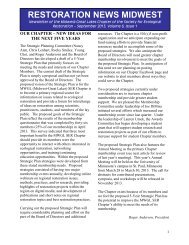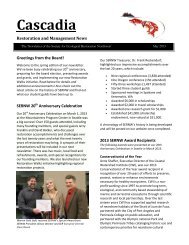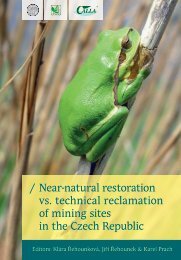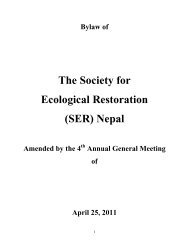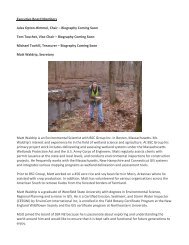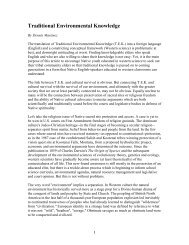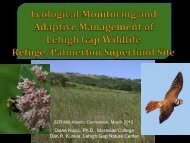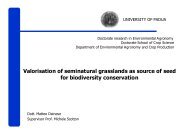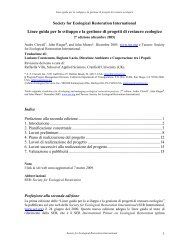THE WORLD CONFERENCE ON ECOLOGICAL RESTORATION
A Global Challenge - Society for Ecological Restoration
A Global Challenge - Society for Ecological Restoration
Create successful ePaper yourself
Turn your PDF publications into a flip-book with our unique Google optimized e-Paper software.
2005 The World Conference on Ecological Restoration 33<br />
Herbivory tolerance of pines is small, so that herbivory damage a seriously affected their development despite<br />
the lower intensity. Our results reveal ungulate herbivory damage as an important factor to be<br />
taken into account as in reforestation planning.<br />
Keywords: Reforestation, ungulate, herbivory, palatability.<br />
Experience in Working out of a Program of Remediation and Development of<br />
Ural Old-Time Industrial Region<br />
Barysheva 1 N.M., E.N. Avrorin 1 , E.V. Polyakov 2 , G.P. Shveikin 2 , G.G. Mikhailov 3 , A.V. Novosyolov 4 ,<br />
B.N. Smirnov 5 , V.N. Udachin 6 , E.O. Shrumm 7<br />
1 FGUP Russian Federal Nuclear Center - VNIITF, Snezhinsk, Russia.<br />
2 Institute of Solid State Chemistry UB RAS, Yekaterinburg, Russia.<br />
3 South-Ural State University, Chelyabinsk, Russia.<br />
4 Administration of Chelyabinsk region, Russia.<br />
5 RF SRC “Ural Metal Institute”, Yekaterinburg, Russia.<br />
6 Institute for Mineralogy UB RAS, Miass, Russia.<br />
7 Administration of the city of Karabash, Russia<br />
A model of working out of a program for stable development of Ural areas of minerals mining and technological<br />
processing suffered real technogenic disasters is discussed. Approaches to this problem resolution<br />
were developed under two ISTC projects taking the city of Karabash, Chelyabinsk region, for example.<br />
The model orients on internal resources of the territory and includes the assessment of environmental,<br />
resource and technological priorities. Conclusion on first-priority measures for the population protection<br />
were made. Effect produced by the Karabash Industrial Area on the region environment was assessed.<br />
All wastes accumulated in Karabash (composition, properties and amounts) were fully investigated. Existing<br />
and innovative technologies for each type of waste treating were searched out and assessed. Some<br />
of them that can be used specifically for Karabash deposits were experimentally proved. A consistent set<br />
of technologies for waste handling and territory and public health remediation was defined.<br />
Keywords: program, remediation, stable development, assessment, environmental, resource, technology,<br />
priorities.<br />
How to preserve the biodiversity in agricultural landscapes?<br />
Batáry 1 P., A. Báldi 2 , S. Erdös 1 , T. Kisbenedek 3 , K.M. Orci 2 , A. Orosz 1 , T. Rédei 4 ,<br />
M. Sárospataki 5 , T. Szüts 6<br />
1 Hungarian Natural History Museum. Budapest. Hungary<br />
2 Animal Ecology Research Group of HAS and Hungarian Natural History Museum. Budapest. Hungary<br />
3 Department of Natural History. Baranya County Museums Directorate. Pécs. Hungary<br />
4 Institute of Ecology and Botany. Vácrátót, Hungary<br />
5 Department of Zoology and Ecology. Szent István University. Hungary<br />
6 Systematic Zoology Research Group of HAS. Budapest. Hungary<br />
The agriculture intensification in the second half of the 20th century resulted in a dramatic decline of<br />
biodiversity in western Europe. However there are also large agricultural landscapes in Central- and<br />
Eastern European countries (CEE), especially in Hungary. The recent joining to the EU of CEE countries<br />
will probably re-structure agriculture there and will threaten the still relatively high biodiversity by increasing<br />
intensification of farmland management. Can agri-environmental programs balance the expected<br />
decline in biodiversity of the CEE countries if farming will be intensified? We studied this question by<br />
comparing birds, arthropods (orthopterans, bees, spiders, beetles and bugs) and plants of 42 extensively<br />
and intensively cattle grazed paired fields in three regions of Hungary (alkali steppes and meadows in<br />
Central Hungary and alkali steppes in Eastern Hungary). The pastures were paired; an extensively and<br />
an intensively grazed site formed the pair. We found more bird species on intensive pastures, which had<br />
more heterogeneous landscapes with farm buildings and shelters, while the number of individuals were<br />
higher in the extensive sites. We generally found more grasshoppers on the extensive sites, however in<br />
the Eastern Hungarian region there was an opposite, but not significant trend. It seems that the abundance<br />
of grasshoppers is determined by the local factors (vegetation, ground, litter cover, etc.) and by the<br />
landscape factors as well. The preliminary results of the other arthropod taxa indicate that intensively<br />
and extensively grazed sites had different assemblages, but this largely depends on the local vegetation<br />
structure.<br />
Keywords: Agriculture intensification, cattle grazing, arthropods, birds, plants.



